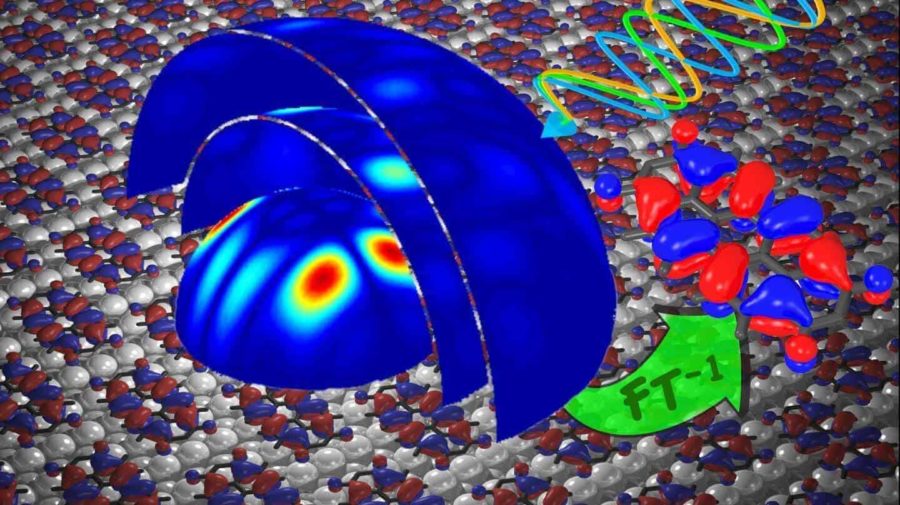Many will remember them from physics lessons at school: Often represented as colorful clouds or balloons, electron orbitals provide information on the whereabouts of the electrons in atoms and molecules. Scientists from the University of Graz, Forschungszentrum Jülich, and the Physikalisch-Technische Bundesanstalt have now succeeded in experimentally recording these structures in all three dimensions. They achieved this by further developing a method they had already applied two years ago to make these orbitals visible in two dimensions. Their findings have now been published in the scientific journal Nature Communications.
In quantum physics, electrons behave both as particles and as waves. The wave nature can be described by the spatial wave function, the orbital. “Orbitals contain information on the spatial distribution of the electrons at a certain energy. If they are known, all the relevant properties of a material can be derived,” explains Prof. Peter Puschnig from the University of Graz. However, the laws of quantum mechanics prevent the direct observation of how an electron propagates as a wave.
In 2004, a team of Canadian and Japanese scientists used a high-energy laser to show that this orbital function can be imaged indirectly – at least for simple diatomic molecules. About ten years later, researchers from Graz and Jülich recorded orbitals of larger complex molecules for the first time, albeit only in two dimensions. For their measurements, they used photoelectron spectroscopy, based on the photoelectric effect. In this procedure, a molecular layer on a silver surface is bombarded with photons (particles of light), causing the energetically excited electrons to be released. “The electrons do not simply fly around in space. Instead, their angular and energy distributions enable us to draw conclusions about the molecular orbitals,” says Puschnig.
By further refining this method, the scientists have now succeeded in reconstructing the orbitals in all three dimensions. This meant that the experiment had to be performed with various photon energies, i.e. different wavelengths of light, in the ultraviolet range. “Additional information on the third dimension can be obtained with variable wavelengths in much the same way as a camera takes repeated pictures of one object with a variable focus,” explains Prof. Stefan Tautz from Forschungszentrum Jülich. However, it took a long time before it was possible to combine the data gathered in different measurement series into one spatial model.
“Until now, we were unable to compare the measured intensities originating from different photon energies,” says Prof. Michael Ramsey from the Department of Physics at the University of Graz. “Together with the photon energy, the photon flux also changes, in other words, the absolute number of incoming photons which have to be known for the 3D reconstruction. But this number is difficult to measure precisely,” adds Dr. Serguei Soubatch from Jülich’s Peter Grünberg Institute (PGI-3).
In order to obtain comparable values, the Jülich researchers installed their detector at the Metrology Light Source (MLS) of the Physikalisch-Technische Bundesanstalt (PTB) in Berlin. “Our synchrotron radiation source is one of the few worldwide that provides a precisely calibrated photon flux,” explains Dr. Alexander Gottwald from PTB. On the basis of the data from the calibrated measurements, the scientists at Graz were then able to reconstruct the electron distributions in three dimensions.
The research team from Jülich, Graz, and Berlin was thus able observe the wave function, which according to the rules of quantum mechanics is in fact considered unobservable. The results are long-sought proof of the orbital concept as such. In 1977, for example, the orbital theorist Kenichi Fukui, who together with Roald Hoffmann received the Nobel Prize for chemistry in 1981, described the concept of molecular orbitals as having a “somewhat unreal nature” (Intern. J. Quantum Chem. 12, 277).
And as Hoffmann said in 1999, even theorists who use orbitals in their daily work do not really credit them with the necessary reality: “[…] the physicists and chemists who use density functional theory so fruitfully have by and large shied away from attributing to […] orbitals the reality that (we think) they deserve” (J. Am. Chem. Soc. 121, 3414).
The result is also relevant for physics: “Our experiment provides important new physical insights into the underlying photoelectric effect,” says Stefan Tautz. Somewhat surprisingly, the electrons that are released can be described in a manner very similar to free electrons – an idea that was rejected almost 50 years ago on the basis of the assumed scattering by the atomic cores.
If our reporting has informed or inspired you, please consider making a donation. Every contribution, no matter the size, empowers us to continue delivering accurate, engaging, and trustworthy science and medical news. Independent journalism requires time, effort, and resources—your support ensures we can keep uncovering the stories that matter most to you.
Join us in making knowledge accessible and impactful. Thank you for standing with us!

